BECKHOFF CX50x0 User Manual
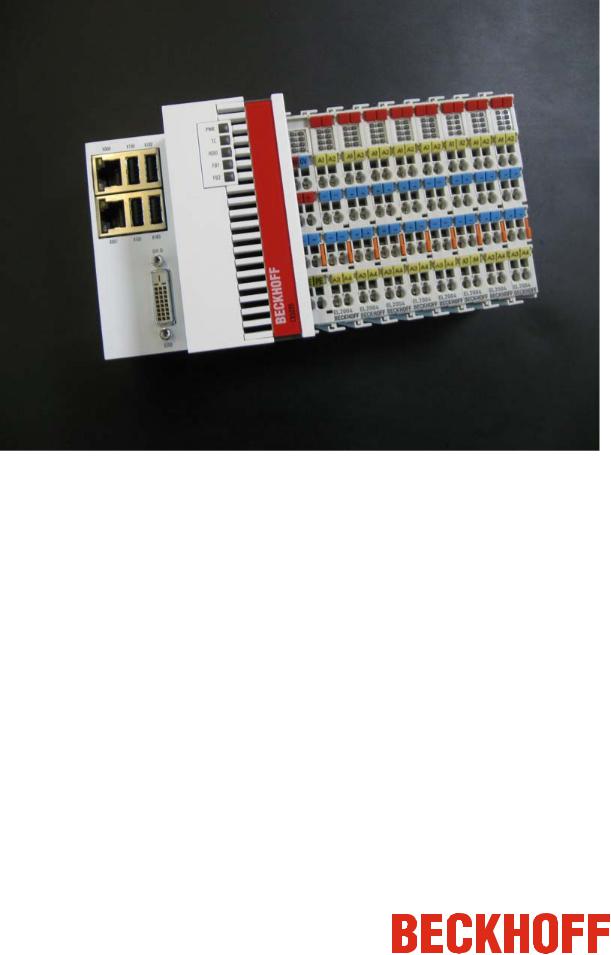
CX50x0 - Hardware Documentation
Version: 1.3
Datum: 2011-05-02

Table of contents
Table of contents
CX50x0 - Hardware Documentation
1. Foreword |
4 |
Notes on the documentation |
4 |
Safety instructions |
4 |
Documentation issue status |
5 |
2. Product overview |
6 |
Appropiate use |
6 |
System overview |
7 |
CX5010 - Technical data |
9 |
CX5020 - Technical data |
10 |
Configurations |
11 |
Battery compartment |
13 |
Compact Flash slot |
14 |
Compact Flash card |
15 |
3. Second-UPS |
16 |
Overview |
16 |
Function blocks |
17 |
FB_S_UPS |
18 |
FB_NT_QuickShutdown |
21 |
Functions |
22 |
F_GetVersionTcSUPS |
22 |
Datatypes |
23 |
E_S_UPS_Mode |
23 |
E_S_UPS_State |
24 |
4. |
Assembly and connecting |
25 |
|
Unpacking, installation and transport |
25 |
|
Dimensions |
26 |
|
Assembly on mounting rail |
28 |
|
Power supply |
30 |
|
DVI-D connection |
32 |
|
USB connections |
33 |
|
LAN connections |
34 |
|
RS232 connection |
35 |
|
RS422/RS485 connection |
36 |
5. |
Operating/Configuration |
37 |
CX50x0 - Hardware Documentation |
1 |

Table of contents
EtherCAT cabel redundancy |
37 |
Switching on / off |
41 |
BIOS Setup |
42 |
Standard CMOS Features |
43 |
IDE Primary Master |
44 |
IDE Primary Slave |
46 |
Advanced BIOS Features |
48 |
CPU Feature |
51 |
Advanced Chipset Features |
52 |
Integrated Peripherals |
53 |
OnChip IDE Device |
54 |
Onboard Device |
55 |
SuperIO Device |
56 |
USB Device |
57 |
Power Management Setup |
58 |
HPET Powermanagement |
59 |
DTS Powermanagement |
60 |
PnP / PCI Configuration |
61 |
IRQ Resources |
62 |
PC Health Status |
63 |
Frequency / Voltage Control |
65 |
6. Error handling and diagnostics |
66 |
CPU basic moule |
66 |
LED CPU basic module |
66 |
LED K-Bus power supply |
67 |
LEDs K-Bus power supply |
69 |
Faults |
70 |
7. |
Decomissioning |
71 |
|
Removal and disposal |
71 |
8. |
Appendix |
73 |
|
Accessories |
73 |
|
Certifications |
74 |
|
Support and service |
75 |
2 |
CX50x0 - Hardware Documentation |

Notes on the documentation
1.Foreword
Notes on the documentation
This description is only intended for the use of trained specialists in control and automation engineering who are familiar with the applicable national standards.
It is essential that the following notes and explanations are followed when installing and commissioning these components.
The responsible staff must ensure that the application or use of the products described satisfy all the requirements for safety, including all the relevant laws, regulations, guidelines and standards.
Disclaimer
The documentation has been prepared with care. The products described are, however, constantly under development.
For that reason the documentation is not in every case checked for consistency with performance data, standards or other characteristics.
In the event that it contains technical or editorial errors, we retain the right to make alterations at any time and without warning.
No claims for the modification of products that have already been supplied may be made on the basis of the data, diagrams and descriptions in this documentation.
Trademarks
Beckhoff®, TwinCAT®, EtherCAT®, Safety over EtherCAT®, TwinSAFE® and XFC® are registered trademarks of and licensed by Beckhoff Automation GmbH.
Other designations used in this publication may be trademarks whose use by third parties for their own purposes could violate the rights of the owners.
Patent Pending
The EtherCAT Technology is covered, including but not limited to the following patent applications and patents: EP1590927, EP1789857, DE102004044764, DE102007017835
with corresponding applications or registrations in various other countries.
The TwinCAT Technology is covered, including but not limited to the following patent applications and patents: EP0851348, US6167425 with corresponding applications or registrations in various other countries.
Copyright
© Beckhoff Automation GmbH.
The reproduction, distribution and utilization of this document as well as the communication of its contents to others without express authorization are prohibited.
Offenders will be held liable for the payment of damages. All rights reserved in the event of the grant of a patent, utility model or design.
CX50x0 - Hardware Documentation |
3 |
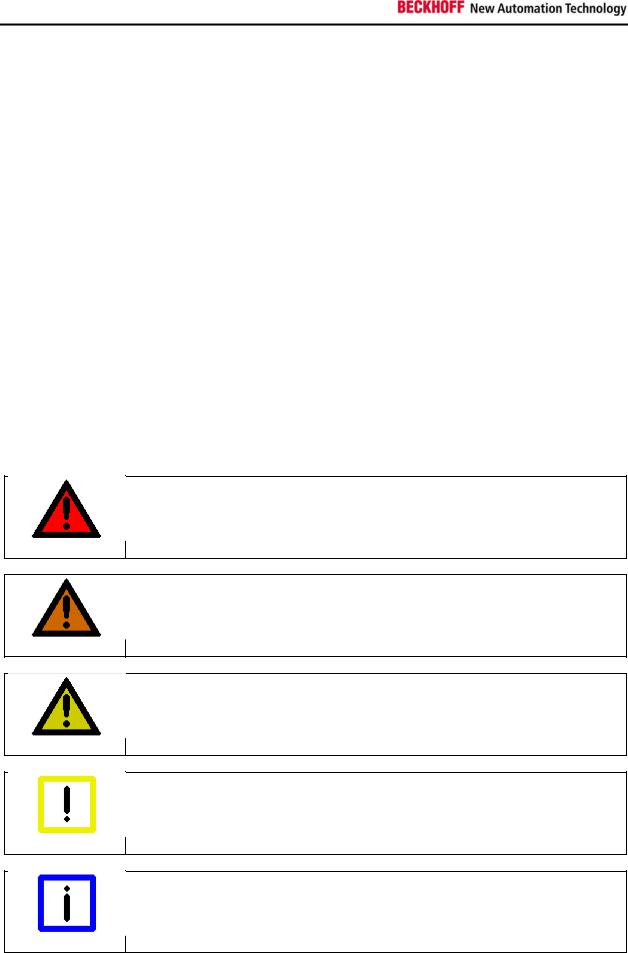
Notes on the documentation
Safety instructions
Safety rules
Consider the following safety instructions and descriptions!
Product specific safety instructions are to be found on the following pages or in the areas mounting, wiring, commissioning etc.
Disclaimer
All the components are supplied in particular hardware and software configurations appropriate for the application. Modifications to hardware or software configurations other than those described in the documentation are not permitted, and nullify the liability of Beckhoff Automation GmbH.
Personnel qualification
This description is only intended for the use of trained specialists in control, automation and drive engineering who are familiar with the applicable national standards.
Description of symbols
The following symbols with a adjoining safety advice or notice are used in this documentation. You have to read the safety advices carefully and adhere them strictly!
Acute risk of injury!
If you do not adhere the safety advice adjoining this symbol, there is immediate danger to life and health of individuals!
DANGER
Risk of injury!
If you do not adhere the safety advice adjoining this symbol, there is danger to life and health of individuals!
WARNING
Hazard to individuals!
If you do not adhere the safety advice adjoining this symbol, there is obvious hazard to individuals!
CAUTION
Hazard to devices and environment
If you do not adhere the notice adjoining this symbol, there is obvious hazard to materials and environment.
Attention
Note or pointer
This symbol indicates information that contributes to better understanding.
Note
4 |
CX50x0 - Hardware Documentation |

Notes on the documentation
Documentation Issue Status
|
Version |
|
|
Changes |
|
|
|
|
|
||
|
|
|
|
|
|
1.3 |
|
Requirements for power supply added |
|||
1.2 |
|
Changes on temperature range and K-bus diagnosis |
|||
1.1 |
|
Changes on system interface N031 and DVI resolution |
|||
|
|
|
|
||
1.0 |
|
|
first release |
||
|
|
|
|||
0.1 |
|
preliminary version |
|||
|
|
|
|
|
|
CX50x0 - Hardware Documentation |
5 |
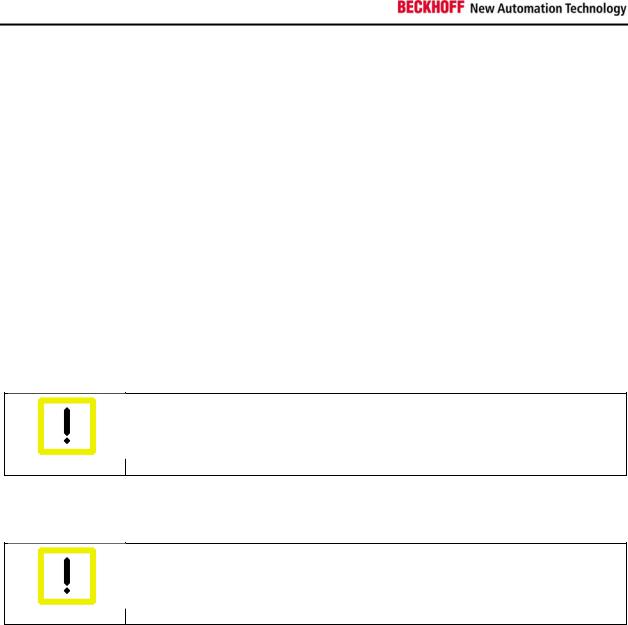
Notes on the documentation
2.Product overview
Intended use
The CX5010 / CX5020 device series is a modular control system designed for top-hat rail installation. The system is scalable, so that the required modules can be assembled and installed in the control cabinet or terminal box as required.
Only switch the PC off after closing the software
Before the Embedded PC is switched off, the software currently running on it should be stopped properly in order to avoid data loss on the hard disk. Please read the section on “Switching off”.
Switch off all system components and uncouple the Industrial PC from the system if the PC is not used for control purposes, e.g. during a function test. To disconnect first pull the first terminal behind the power supply unit (optional), then pull the connectors of the fieldbus connections.
System components that have been switched off must be secured against being switched on again.
The Embedded PC’s power supply unit must be supplied with 24 VDC.
Damage to the environment or devices
|
Do not exchange any parts when under power! Replacing control components while the |
|
system is live may lead to short circuits or overvoltages, which in turn may damage the |
Attention |
controller and connected peripherals (terminals, monitors, input devices etc.). |
When components are being fitted or removed, the supply voltage must be switched off.
Software knowledge
System malfunctions
Requires software knowledge! Each user must be familiar with all the functions of the software installed on the PC to which he has access.
Attention
6 |
CX50x0 - Hardware Documentation |
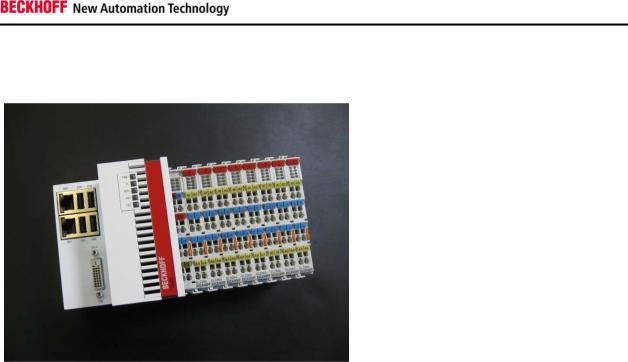
Notes on the documentation
System Overview
The system
The CX5000 series devices are DIN rail-mountable, fanless Embedded PCs with direct connection for Beckhoff Bus Terminals or EtherCAT terminals. In contrast to the other CX device families, the CX5000 series has a fixed, nonexpandable number of system interfaces. The housing design for this series is optimised for robustness and compactness. No modular expandability for the left-hand side is provided. Although EtherCAT integration offers a wide range of expansion capability. Further master/slave fieldbus connections (PROFIBUS, CANopen, DeviceNet) or communication interfaces (RS232, RS422/RS485) and all other signal types accessible via EtherCAT can be directly connected as EtherCAT Terminals. Two independent Gigabit Ethernet ports and four USB 2.0 interfaces are available. A Beckhoff control panel or a commercially available DVI monitor can be connected to the DVI D interface. A serial port (RS232/RS422/RS485) or a fieldbus connection with master or slave function can be added as an optional interface as required. An interchangeable Compact Flash card located behind a flap that is accessible from outside is used as boot and storage medium. The built-in capacitive 1-second UPS ensures secure backup of persistent application data on the Compact Flash card. The date and time are buffered via a replaceable battery. The operating system can be Windows CE or Windows Embedded Standard. The TwinCAT automation software transforms a CX5000 system into a powerful PLC and motion control system that can be operated with or without visualisation.
EtherCAT as a fast I/O system
Like all Embedded PCs from the CX series (except CX100x), the CX5000 was developed for optimum interaction with EtherCAT. One of the two independent Ethernet interfaces of the CPU module (X001) is intended for EtherCAT mode. The primary EtherCAT connection is generally established via terminals. Both can also be configured as a ring in order to achieve line redundancy.
Interestingly, EtherCAT offers several options for connecting conventional fieldbus systems to the CX50x0:
As EtherCAT device in terminal form, for example the PROFIBUS master as EtherCAT Terminal EL6731. In practice, this means that the PROFIBUS master can be positioned exactly where it is required within a machine. It no longer has to be implemented as a plug-in card in the IPC or a master controller in the control cabinet.
PLC, Motion Control, interpolation and visualisation
As a DIN rail IPC and in conjunction with the TwinCAT software from Beckhoff, the CX50x0 offers the same functionality as large Industrial PCs. In terms of PLC, up to four virtual IEC 61131 CPUs can be programmed with up to four tasks each, with a minimum cycle time of 50 μs. All IEC 61131-3 languages can be used.
Moreover, all TwinCAT functionalities are available for Motion Control applications:
In theory, up to 256 axes can be controlled. In addition to simple point-to-point movements, more complex multi-axis functions such as “electronic gearbox”, “cam plates” and “flying saw” can be implemented.
In addition to real-time execution of control tasks, the TwinCAT real-time kernel ensures that enough time remains for the user interface (HMI), to communicate with the real-time components via software interfaces such as ADS or OPC.
For CX50x0 the familiar basic principle applies: it is a programming tool for all controllers.
CX50x0 - Hardware Documentation |
7 |

Notes on the documentation
The complete programming of PLC, Motion Control and visualisation is transferable to all PC controls from Beckhoff, which is reassuring in cases where it becomes apparent during a project that more processing power is required after all. In this case a system with higher performance can be used.
Fieldbus interfaces
The fieldbus interfaces are currently available as master and slave versions for the following field busses:
Optional interfaces:
The optional interfaces can be used to connect single-channel fieldbus interfaces. Operation is limited to one interface at a time. If several fieldbus interfaces are required, they can be added as E-bus terminals (EL67xx). The following fieldbus interfaces are available:
CX50x0-N030 = RS232, D-Sub connector
CX50x0-N031 = RS422/RS485, D-Sub socket
CX50x0-M310 = PROFIBUS master, D-Sub socket, 9-pin
CX50x0-B310 = PROFIBUS slave, D-Sub socket, 9-pin
CX50x0-M510 = CANopen master, D-Sub connector, 9-pin
CX50x0-B510 = CANopen slave, D-Sub connector, 9-pin
CX50x0-M930 = PROFINET RT, controller, Ethernet (2 x RJ-45 switch)
CX50x0-B930 = PROFINET RT, device, Ethernet (2 x RJ-45 switch)
CX50x0-B951 = Ethernet/IP slave, Ethernet (2 x RJ-45 switch)
CX50x0-B100 = EtherCAT slave, EtherCAT IN and OUT (2 x RJ 45)
The software
In combination with the TwinCAT automation software, the CX50x0 Industrial PC becomes a powerful IEC 61131-3 PLC with up to four user tasks. Additionally, Motion Control tasks can also be executed. Depending on the required cycle time, several servo axes can be controlled. Even special functions such as flying saw, electronic gearbox and cam plate can be realised.
The CX50x0 system is programmed in the same way as other bus controllers:
Remote programming via Ethernet
This option is used if the basic unit is equipped with “Windows CE.NET”. In this case, the system is programmed via a laptop or a desktop PC, which is connected to the CX via Ethernet (network or crossover cable). The programs are developed on the laptop with a standard TwinCAT software license and then loaded into the target device.
Visualisation
The Beckhoff OPC server is available for interfacing with SCADA packets, if the two operating system variants “Windows CE.NET” or “Windows XP Embedded” are used. In other words, the CX50x0 also offers straightforward visualisation and simultaneous control in real-time on a single system.
8 |
CX50x0 - Hardware Documentation |
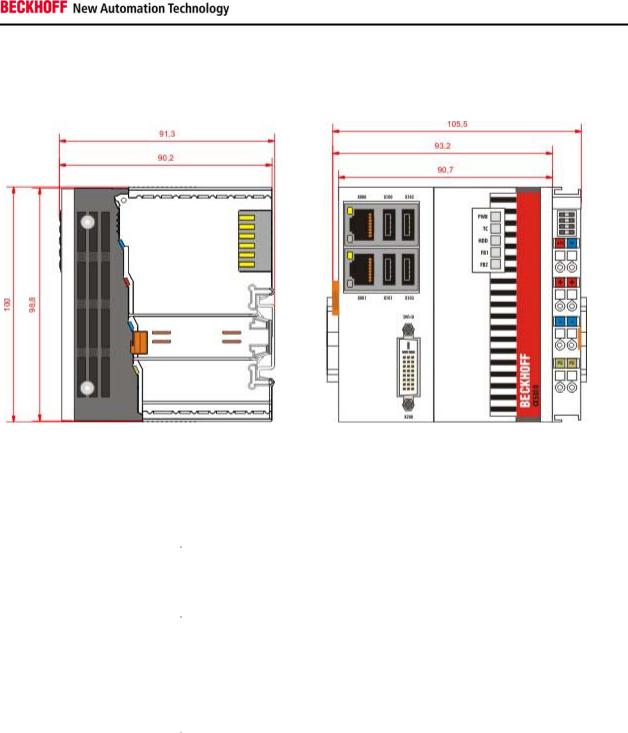
Notes on the documentation
CX5010 Technical data
The basic configuration of the CX5010 includes a 64 MB Compact Flash card. The basic configuration includes two Ethernet RJ-45 interfaces, four USB-2.0 interfaces and a DVI-D interface.
|
Technical data |
|
|
CX5010 |
|
|
|
|
|
||
|
|
|
|
||
|
Processor |
|
Intel® Atom™ Z510 processor, 1.1 GHz clock frequency |
||
|
|
|
|
||
|
Internal Flash memory |
|
64 MB Compact Flash card |
||
|
|
|
|
||
|
Internal main memory |
|
512 MB RAM (interior, not expandable) |
||
|
|
|
|||
|
Interfaces |
2 x RJ 45, 10/100/1000 Mbit/s, DVI-D, 4 x USB 2.0 |
|||
|
|
|
|||
|
Diagnostics LED |
1 x power, 1 x TC status, 1 x flash access, 2 x bus status |
|||
|
Clock |
|
Internal clock with battery backup for time and date (battery replaceable) |
||
|
|
|
|||
|
Operating system |
Microsoft Windows CE or Microsoft Windows Embedded Standard |
|||
|
|
|
|
||
|
Control software |
|
TwinCAT PLC runtime or TwinCAT NC PTP runtime |
||
|
|
|
|||
|
Power supply |
24 V DC (-15 %/+20 %) |
|||
|
|
|
|||
|
Power supply |
I/O terminals 2 A |
|||
|
Max. power loss |
|
12 W (including system interfaces) |
||
|
|
|
|||
|
Dielectric strength |
500 Veff (supply/internal electronics) |
|||
|
|
|
|
||
|
Dimensions (H x W x D) |
|
100 mm x 106 mm x 92 mm |
||
|
|
|
|
||
|
Weight |
|
approx. 575 g |
||
|
|
|
|
||
|
Operating/storage temperature |
|
-25°C ... +60°C / -40°C ... +85°C |
||
|
Relative humidity |
|
95 % no condensation |
||
|
|
|
|
||
|
Vibration/shock resistant |
|
conforms to EN 60068-2-6/EN 60068-2-27/ 29 |
||
|
|
|
|||
|
EMC immunity/emission |
conforms to EN 61000-6-2 / EN 61000-6-4 |
|||
|
|
|
|
||
|
Protection class |
|
IP 20 |
||
|
|
|
|
|
|
Further Information: www.beckhoff.de/CX5010
CX50x0 - Hardware Documentation |
9 |
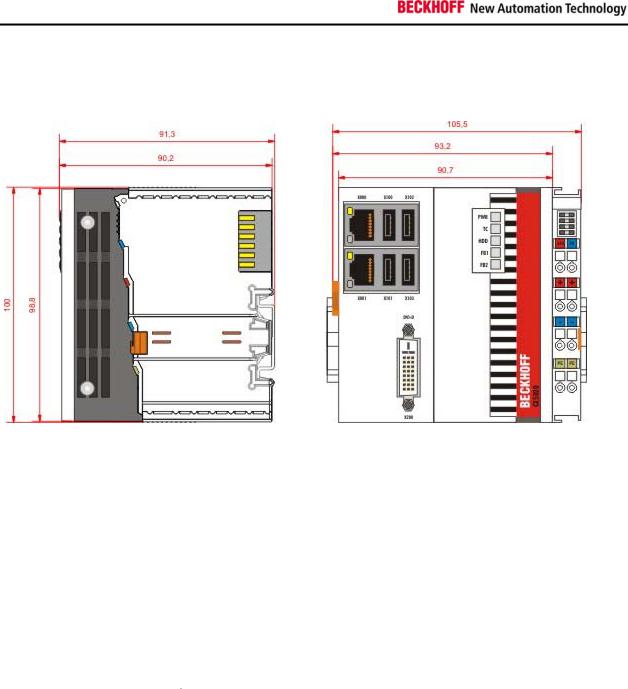
Notes on the documentation
CX5020 - Technical data
The basic configuration of the CX5010 includes a 64 MB Compact Flash card. The basic configuration includes two Ethernet RJ-45 interfaces, four USB-2.0 interfaces and a DVI-D interface.
|
Technical data |
|
|
CX5010 |
|
|
|
|
|
||
|
|
|
|
||
|
Processor |
|
Intel® Atom™ Z530 processor, 1.6 GHz clock frequency |
||
|
|
|
|
||
|
Internal Flash memory |
|
64 MB Compact Flash card |
||
|
Internal main memory |
|
512 MB RAM (interior, not expandable) |
||
|
|
|
|||
|
Interfaces |
2 x RJ 45, 10/100/1000 Mbit/s, DVI-D, 4 x USB 2.0 |
|||
|
|
|
|||
|
Diagnostics LED |
1 x power, 1 x TC status, 1 x flash access, 2 x bus status |
|||
|
|
|
|
||
|
Clock |
|
Internal clock with battery backup for time and date (battery replaceable) |
||
|
|
|
|||
|
Operating system |
Microsoft Windows CE or Microsoft Windows Embedded Standard |
|||
|
Control software |
|
TwinCAT PLC runtime or TwinCAT NC PTP runtime |
||
|
|
|
|||
|
Power supply |
24 V DC (-15 %/+20 %) |
|||
|
|
|
|||
|
Power supply |
I/O terminals 2 A |
|||
|
|
|
|
||
|
Max. power loss |
|
12.5 W (including system interfaces) |
||
|
|
|
|||
|
Dielectric strength |
500 Veff (supply/internal electronics) |
|||
|
Dimensions (H x W x D) |
|
100 mm x 106 mm x 92 mm |
||
|
|
|
|
||
|
Weight |
|
approx. 575 g |
||
|
|
|
|
||
|
Operating/storage temperature |
|
-25 C ... +60°C / -40 C ... +85°C |
||
|
|
|
|
||
|
Relative humidity |
|
95 % no condensation |
||
|
|
|
|
||
|
Vibration/shock resistant |
|
conforms to EN 60068-2-6/EN 60068-2-27/ 29 |
||
|
EMC immunity/emission |
conforms to EN 61000-6-2 / EN 61000-6-4 |
|||
|
|
|
|
||
|
Protection class |
|
IP 20 |
||
|
|
|
|
|
|
Further Information: www.beckhoff.de/CX5020
10 |
CX50x0 - Hardware Documentation |
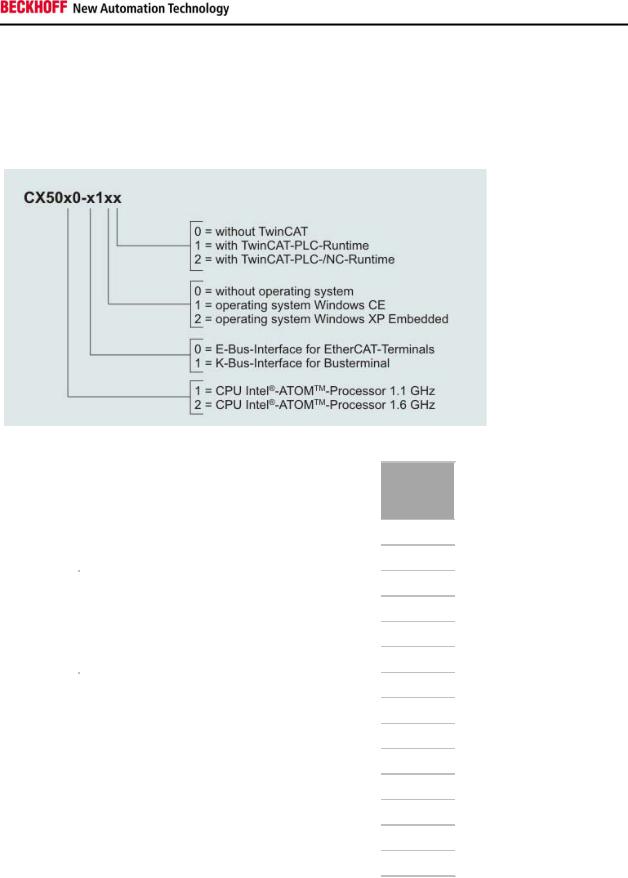
Notes on the documentation
Types
The CPU module can be equipped with different hardware and software options: "Windows CE" or "Windows Embedded Standard" are available as operating system. The TwinCAT automation software transforms a CX50x0 system into powerful PLC and Motion Control system that can be operated with or without visualisation. Further system interfaces (pre-installed in the factory) or fieldbus connections can be added to the basic CPU module.
The CX 50x0 modules are available in the following types:
|
|
|
|
|
|
|
Windows |
|
|
|
TwinCAT |
|
|
|
TwinCAT |
|
|
|
|
|
|
|
|
|
|
|
|
|
|
|
|||
|
K- |
E- |
CPU- |
without |
Windows |
|
Embedded |
|
without |
|
PLC |
|
|
|
NC PTP |
|
Modul |
BUS |
BUS |
frequency |
OS |
CE |
|
Standard |
|
TwinCAT |
|
Runtime |
|
|
|
Runtime |
|
|
|
|
|
|
|
|
|
|
|
|
|
|
|
|
|
|
CX5020-0100 |
|
X |
1,6 GHz |
X |
- |
- |
|
X |
- |
|
- |
|
||||
|
|
|
|
|
|
|
|
|
|
|
|
|
||||
CX5020-0110 |
|
X |
1,6 GHz |
- |
X |
- |
|
X |
- |
|
|
- |
|
|||
|
|
|
|
|
|
|
|
|
|
|
|
|
|
|||
CX5020-0111 |
|
X |
1,6 GHz |
- |
X |
- |
|
- |
|
X |
|
- |
|
|||
|
|
|
|
|
|
|
|
|
|
|
|
|
|
|||
CX5020-0112 |
|
X |
1,6 GHz |
- |
X |
- |
|
- |
- |
|
|
|
X |
|||
|
|
|
|
|
|
|
|
|
|
|
|
|
|
|||
CX5020-0120 |
|
X |
1,6 GHz |
- |
- |
|
X |
|
X |
- |
|
- |
|
|||
|
|
|
|
|
|
|
|
|
|
|
|
|
|
|||
CX5020-0121 |
|
X |
1,6 GHz |
- |
- |
|
X |
|
- |
|
X |
- |
|
|||
|
|
|
|
|
|
|
|
|
|
|
|
|
|
|
||
CX5020-0122 |
|
X |
1,6 GHz |
- |
- |
|
X |
|
X |
- |
|
|
|
X |
||
|
|
|
|
|
|
|
|
|
|
|
|
|
||||
CX5020-1100 |
X |
- |
1,6 GHz |
X |
- |
- |
|
X |
- |
|
- |
|
||||
|
|
|
|
|
|
|
|
|
|
|
|
|
||||
CX5020-1110 |
X |
- |
1,6 GHz |
- |
X |
- |
|
X |
- |
|
- |
|
||||
|
|
|
|
|
|
|
|
|
|
|
|
|
||||
CX5020-1111 |
X |
- |
1,6 GHz |
- |
X |
- |
|
- |
|
X |
- |
|
||||
|
|
|
|
|
|
|
|
|
|
|
|
|
|
|||
CX5020-1112 |
X |
- |
1,6 GHz |
- |
X |
- |
|
- |
- |
|
|
|
X |
|||
|
|
|
|
|
|
|
|
|
|
|
|
|
|
|||
CX5020-1120 |
X |
- |
1,6 GHz |
- |
- |
|
X |
|
X |
- |
|
- |
|
|||
|
|
|
|
|
|
|
|
|
|
|
|
|
|
|||
CX5020-1121 |
X |
- |
1,6 GHz |
- |
- |
|
X |
|
- |
|
X |
- |
|
|||
|
|
|
|
|
|
|
|
|
|
|
|
|
|
|
||
CX5020-1122 |
X |
- |
1,6 GHz |
- |
- |
|
X |
|
X |
- |
|
|
|
X |
||
|
|
|
|
|
|
|
|
|
|
|
|
|
|
|
|
|
CX50x0 - Hardware Documentation |
11 |
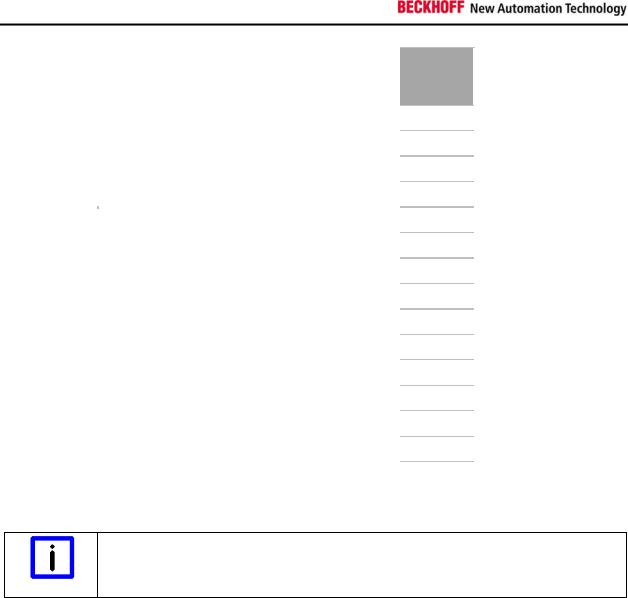
Notes on the documentation
|
|
|
|
|
|
|
Windows |
|
|
|
TwinCAT |
|
|
TwinCAT |
|
|
|
|
|
|
|
|
|
|
|
|
|
|
|||
|
K- |
E- |
CPU- |
without |
Windows |
|
Embedded |
|
without |
|
PLC |
|
|
NC PTP |
|
Modul |
BUS |
BUS |
frequency |
OS |
CE |
|
Standard |
|
TwinCAT |
|
Runtime |
|
|
Runtime |
|
|
|
|
|
|
|
|
|
|
|
|
|
|
|
|
|
CX5020-0100 |
|
X |
1,6 GHz |
X |
- |
- |
|
X |
- |
|
- |
|
|||
|
|
|
|
|
|
|
|
|
|
|
|
|
|||
CX5020-0110 |
|
X |
1,6 GHz |
- |
X |
- |
|
X |
- |
|
- |
|
|||
|
|
|
|
|
|
|
|
|
|
|
|
|
|||
CX5020-0111 |
|
X |
1,6 GHz |
- |
X |
- |
|
- |
|
X |
- |
|
|||
|
|
|
|
|
|
|
|
|
|
|
|
|
|||
CX5020-0112 |
|
X |
1,6 GHz |
- |
X |
- |
|
- |
- |
|
|
X |
|||
|
|
|
|
|
|
|
|
|
|
|
|
|
|
||
CX5020-0120 |
|
X |
1,6 GHz |
- |
- |
|
X |
|
X |
- |
|
- |
|
||
|
|
|
|
|
|
|
|
|
|
|
|
|
|
||
CX5020-0121 |
|
X |
1,6 GHz |
- |
- |
|
X |
|
- |
|
X |
- |
|
||
|
|
|
|
|
|
|
|
|
|
|
|
|
|
||
CX5020-0122 |
|
X |
1,6 GHz |
- |
- |
|
X |
|
X |
- |
|
|
X |
||
|
|
|
|
|
|
|
|
|
|
|
|
|
|||
CX5020-1100 |
X |
- |
1,6 GHz |
X |
- |
- |
|
X |
- |
|
- |
|
|||
|
|
|
|
|
|
|
|
|
|
|
|
|
|||
CX5020-1110 |
X |
- |
1,6 GHz |
- |
X |
- |
|
X |
- |
|
- |
|
|||
|
|
|
|
|
|
|
|
|
|
|
|
|
|||
CX5020-1111 |
X |
- |
1,6 GHz |
- |
X |
- |
|
- |
|
X |
- |
|
|||
|
|
|
|
|
|
|
|
|
|
|
|
|
|||
CX5020-1112 |
X |
- |
1,6 GHz |
- |
X |
- |
|
- |
- |
|
|
X |
|||
|
|
|
|
|
|
|
|
|
|
|
|
|
|
||
CX5020-1120 |
X |
- |
1,6 GHz |
- |
- |
|
X |
|
X |
- |
|
- |
|
||
|
|
|
|
|
|
|
|
|
|
|
|
|
|
||
CX5020-1121 |
X |
- |
1,6 GHz |
- |
- |
|
X |
|
- |
|
X |
- |
|
||
|
|
|
|
|
|
|
|
|
|
|
|
|
|
||
CX5020-1122 |
X |
- |
1,6 GHz |
- |
- |
|
X |
|
X |
- |
|
|
X |
||
|
|
|
|
|
|
|
|
|
|
|
|
|
|
|
|
CX50x0 systems with Windows Embedded Standard require a Compact Flash card with a minimum capacity of 2 GB.
Software Images
A list of the different software images can be found in the CX1000 Software Documen- Note tation.
12 |
CX50x0 - Hardware Documentation |
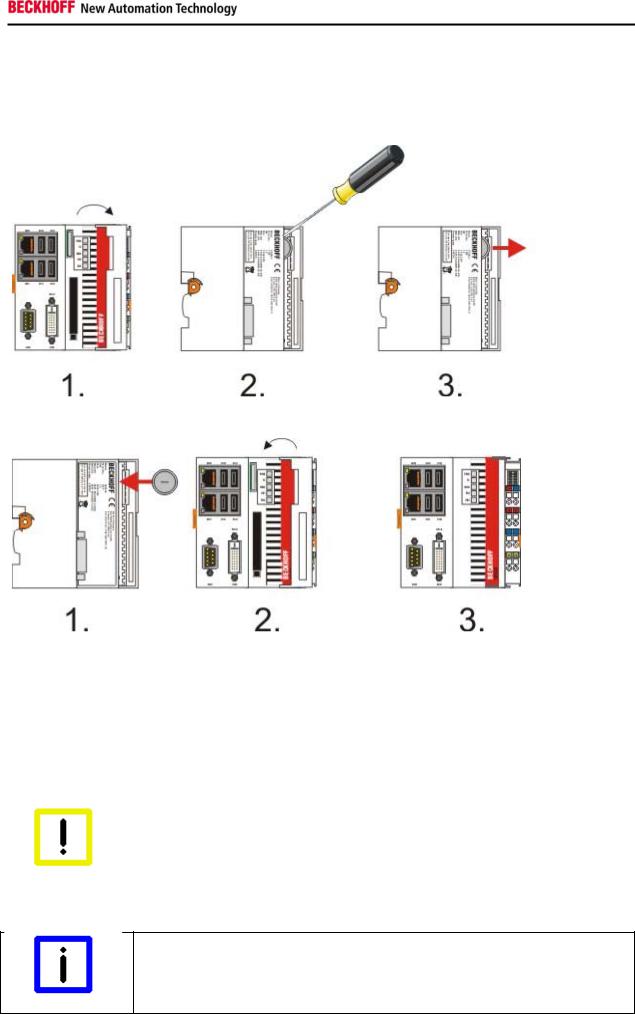
Notes on the documentation
Battery compartment
The battery compartment is located under the front cover of the CX50x0. The opening in which the battery bracket is mounted can be seen when the front cover is opened. Use a screwdriver to carefully lift the battery out of the bracket.
To insert a new battery push it into the battery compartment. Ensure correct polarity. Then close the front cover. The battery change is then complete.
The battery is a CR2032 type from Panasonic.
The correct specifications are:
|
|
Battery |
|
Electrical properties (at 20°C) |
|
Standard charge |
Dimensions |
|
|
|||
|
|
type |
|
|
|
|
|
|
|
|
|
|
|
|
|
Nominal voltage |
Nominal capacity |
|
Continuous load |
Diameter |
Height |
Wight |
|
||
|
|
|
|
|
|
|||||||
|
|
|
|
|
|
|
|
|
|
|
|
|
|
|
CR2032 |
3.0 V |
|
225 mAh |
|
0.20 mA |
20.0 mm |
3.20 mm |
3.1 g |
|
|
|
|
|
|
|
|
|
|
|
|
|
|
|
|
|
|
|
|
|
|
|
|
|
|||
|
|
|
|
|
An incorrectly inserted battery may explode! |
|
|
|
|
|||
|
|
|
|
|
Only use the same battery type (CR2032) from Sanyo or Panasonic. |
|
|
|||||
|
|
|
|
|
It is essential that positive and negative terminals of the battery are inserted correctly |
|
||||||
|
|
Attention |
(negative pole on the left) |
|
|
|
|
|
||||
|
|
|
|
|
Never open the battery or throw it into a fire. |
|
|
|
|
|||
|
|
|
|
|
The battery cannot be recharged. |
|
|
|
|
|
||
Battery maintenance
The battery must be replaced every 5 years.
Spare batteries can be ordered from Beckhoff Service
Note
CX50x0 - Hardware Documentation |
13 |
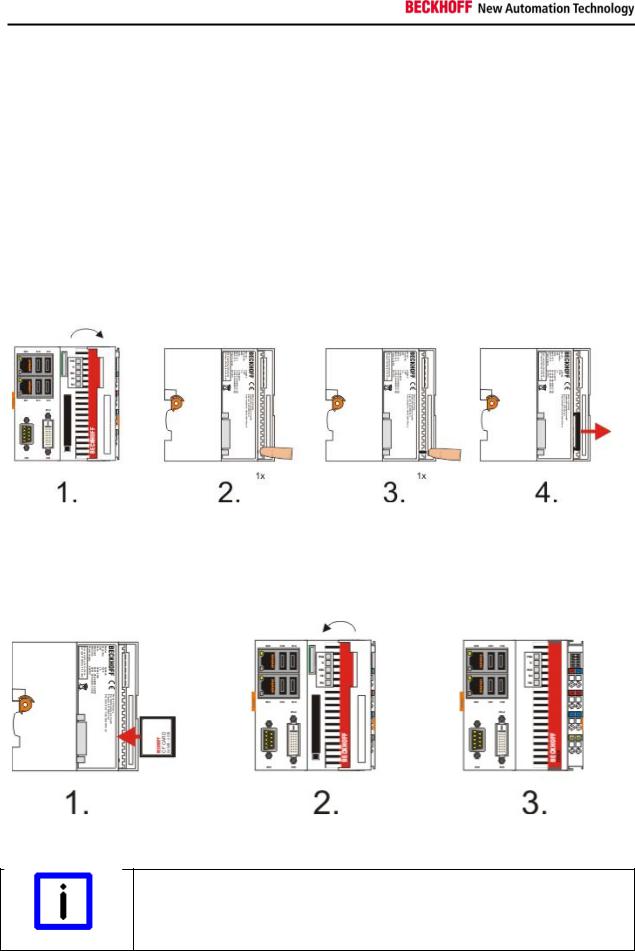
Notes on the documentation
CF slot
A Compact Flash slot is located at the front, which enables the storage medium to be replaced. In the basic module this should only be done in switched-off state, otherwise the system may crash. The Compact Flash card can be removed from the module for maintenance. In this way it is also possible to expand the system (only operating system and program memory). Compact Flash cards (CF cards) are available as accessories in various sizes.
The following images illustrate the handling of the CF cards. Open the front cover. Then eject mechanism and the CF card slot are then visible. The eject mechanism is based on the push-push principle: If the head of the mechanical system is retracted, pushing it makes it move out of the housing. Pushing the head again will lock it back in the housing. At the same time the card moves approx. 4 mm out of the housing, so that it can be pulled out. If the card is pushed in (FIGURE 3), the eject mechanism will re-engage. The card is positioned correctly, if it is located approx. 1 mm lower than the front of the housing.
When the card is pushed back the eject mechanism locks again. The card is positioned correctly, if it is located approx. 1 mm lower than the front of the housing.
Type of CF slot
The Compact Flash slot is a memory interface, not an I/O type CF slot.
Note
14 |
CX50x0 - Hardware Documentation |

Notes on the documentation
CF card
The Compact-Flash card (CF card) is a non-volatile memory.
Data to be retained in the event of a power failure should be saved on the CF card. The CF card operates like a hard disk.
Using CF cards
We strongly recommend that only CF cards supplied by Beckhoff Automation GmbH should be used.
Note These are industrial CF cards with a higher number of write/read cycles and an extended temperature range (+85 °C).
Proper operation can only be guaranteed with CF cards from Beckhoff Automation GmbH!
CX50x0 - Hardware Documentation |
15 |
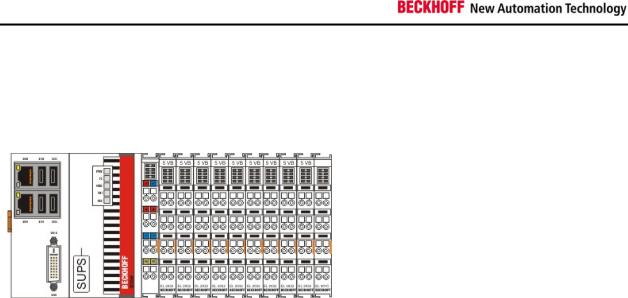
Notes on the documentation
3.Second-UPS
S-UPS: capacitive seconds UPS
The CX50x0 family features a built-in capacitive one-second UPS. It ensures a safe storage of the persistent application data on the Compact Flash card.
Up to 1 MB of data can be saved. The UPS can be switched on and off via the BIOS:
Phoenix - AwardBIOS CMOS Setup Utility
PC Health Status
|
SUSV |
|
|
|
[Enabled] |
|
|
Item |
Help |
|
|
|
|
|
|
|
|
|
|
||||
|
|
|
|
|
|
|
|
||||
|
|
|
|
|
|
|
|
|
|
|
|
|
SUSV holds USB |
|
|
[Enabled] |
|
|
|
|
|
||
|
SUSV Status |
|
|
100% Cap. / Charging |
|
|
|
|
|
||
|
On Die Digital Temp. |
|
|
47°C |
|
|
|
|
|
||
|
Temp. Board |
|
|
56°C |
|
|
|
|
|
||
|
Temp DDR |
|
|
57°C |
|
|
|
|
|
||
|
|
|
|
|
|
|
|
|
|
||
|
CPU Core |
|
|
1.07V |
|
|
|
|
|
||
|
|
|
|
|
|
|
|
|
|
||
|
SCH Core |
|
|
1.04V |
|
|
|
|
|
||
|
|
|
|
|
|
|
|
|
|
|
|
|
|
|
|
... |
|
|
|
|
|
|
|
|
|
|
|
|
|
|
|
|
|
|
|
SUSV
Option for deactivating the one-second UPS.
SUSV holds USB
If system buffering based on SUSV is active, this option can be used to switch the power supply for the USB port on or off. This is important for data back-up on a USB storage medium, for example.
SUSV Status
This value indicates the status of the one-second UPS.
n% Cap. (n={0..100}) indicates the capacity of the UPS.
State (charging / discharging) describes the state of the one-second UPS.
Integration into a PLC
TwinCAT offers special function blocks for integrating the S-UPS into a PLC program. These are described below. From TwinCAT 2.11R2 Build 2016 the required library is integrated in the installation. For older versions the library TcSUPS.lib has to be copied into the TwinCAT library directory.
16 |
CX50x0 - Hardware Documentation |
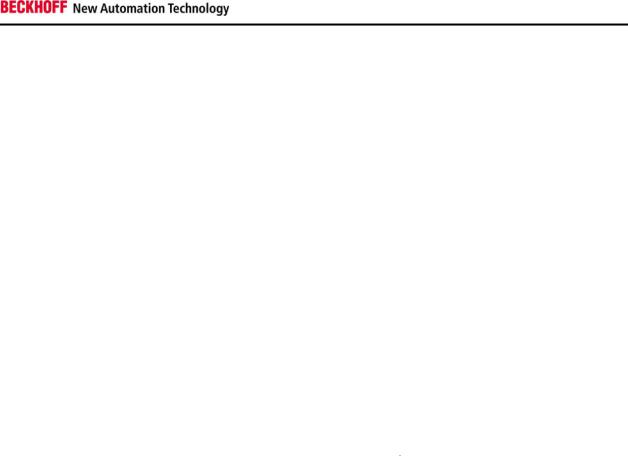
Notes on the documentation
Overview
This library contains functions and function blocks which are needed in order to use the Seconds UPS. See sample project Sample_S_UPS.pro.
Function Blocks
|
Name |
|
|
Description |
|
|
|
|
|
||
|
|
|
|
||
|
FB_S_UPS |
|
Function block to use the Seconds UPS from the PLC. |
||
|
FB_NT_QuickShutdown |
|
Internal function block for the QuickShutdown, used by the FB_S_UPS. |
||
|
|
|
|
|
|
Functions
|
Name |
|
|
Description |
|
|
|
|
|
||
|
|
|
|||
|
F_GetVersionTcSUPS |
The function returns library version info. |
|||
|
|
|
|
|
|
Requirements
|
Component |
|
|
Version |
|
|
|
|
|
||
|
|
|
|||
|
TwinCAT on the development PC, on the target system |
2.11 Build 1542 or higher |
|||
|
|
|
|
|
|
CX50x0 - Hardware Documentation |
17 |

Notes on the documentation
FUNCTION_BLOCK FB_S_UPS
The function block FB_S_Ups can be used on PCs with Seconds UPS, to communicate from the PLC with the UPS. The FB_S_Ups can be used to save persistent data and to QuickShutdown the PC in case of a power failure. The INPUTs of the FB_S_UPS should be used with the default values.
Data loss
The Seconds UPS is only capable of holding the voltage for a few seconds. This is just enough time to save the persistent data. The used persistent saving mode must be
Attention "SPDM_2PASS", even though if this could causes realtime problems. The router memory must be big enough in order to save the persistent data!
Mode eSUPS_WrPersistData_Shutdown (default setting): The persistenten data are written and a QuickShutdown is automatically performed.
Mode eSUPS_WrPersistData_NoShutdown: Only the persistenten data are written, a QuickShutdown will not be performed.
Mode eSUPS_ImmediateShutdown: a QuickShutdown is immediatelly performed.
Mode eSUPS_CheckPowerStatus: only the powerfailure will be detected, no action is performed. In case of the powerfailure the FB waits until the tRecoverTime (10s) has expired before it goes back to the PowerOK state.
The UPS will switch off the main board after the capacitors have been discharged, independent of the mode and therefore independent of the writing of the persistent data and of the QuickShutdown, even if the power supply is restored.
The capacity of the UPS is to small to hold the system alive during longer power outages. The saving of the persistent data has to be done to the Compact Flash, since a hard disk cannot be operated if the UPS supplies the voltage. After the saving of the persistent data a QuickShutdown will be executed.
Attention if files are modified:
|
If other applications or the PLC are keeping files open or write to files during a power |
|
failure, then these files can get corrupted, since the QuickShutdown immediately reboots |
Attention |
the PC. |
|
|
|
Attention if using Windows XP embedded: |
|
The EWF (Enhanced Write Filter) or the FBWF (File Based Write Filter) has to be activated |
|
in order to ensure the validity of the Windows XP embedded files on systems with a |
Attention |
Seconds UPS. |
In case of the EWF the TwinCAT\Boot folder needs to be located on a not protected partition (see in the registry: HKEY_LOCAL_MACHINE\SOFTWARE\Beckhoff\TwinCAT\System\BootPrjPath).
In case of the FBWF the TwinCAT\Boot folder needs to be excluded from the protection (see Beckhoff FBWF Manager, Exclusion Settings).
18 |
CX50x0 - Hardware Documentation |
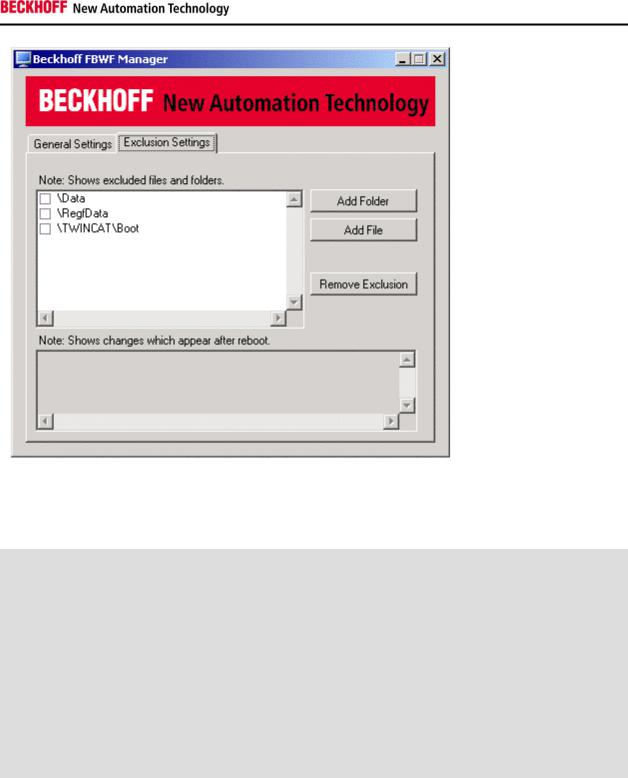
Notes on the documentation
FUNCTION_BLOCK FB_S_UPS
VAR_INPUT
VAR_INPUT |
|
|
sNetID |
: T_AmsNetId := ''; |
(* '' = local netid *) |
iPLCPort |
: UINT := AMSPORT_R0_PLC_RTS1; |
(* PLC Runtime System for |
writing persistent data *) |
|
|
iUPSPort |
: UINT := 16#4A8; |
(* Port for reading Power |
State of UPS, dafault 16#4A8 *) |
|
|
tTimeout |
: TIME := DEFAULT_ADS_TIMEOUT; |
(* ADS Timeout *) |
eUpsMode |
: E_S_UPS_Mode := eSUPS_WrPersistData_Shutdown; (* UPS mode |
|
(w/wo writing persistent data, w/wo shutdown) *)
ePersistentMode : E_PersistentMode := SPDM_2PASS; (* mode for writing persistent data *)
tRecoverTime : TIME := T#10s; (* ON time to recover from short power failure in mode eSUPS_WrPersistData_NoShutdown/eSUPS_CheckPowerStatus *)
END_VAR
sNetID |
: AmsNetID of the PC. |
iPLCPort |
: Port number of the PLC runtime system (AMSPORT_R0_PLC_RTS1 = 801, |
AMSPORT_R0_PLC_RTS2 = 811, AMSPORT_R0_PLC_RTS3 = 821, AMSPORT_R0_PLC_RTS4 = 831). |
|
iUPSPort |
: Port number for reading the UPS-State (default value is 16#4A8). |
tTimeout |
: Timeout for the execution of the QuickShutdown. |
eUpsMode |
: eUpsMode defines, if persistent data need to be written and if a QuickShutdown needs to be |
executed. |
|
The default value is eSUPS_WrPersistData_Shutdown, means with writing of the persistent data and then a QuickShutdown. See E_S_UPS_Mode.
ePersistentMode : Mode for the writing of the persistent data. Default value is SPDM_2PASS.
tRecoverTime : Time which will be waited after a power failure (in case of UPS modes without shutdown) to go back to the status PowerOK.
CX50x0 - Hardware Documentation |
19 |

Notes on the documentation
The tRecoverTime needs to be a little bit bigger than the maximum holding time of the UPS, since the UPS will shut off even if the power supply is restored.
VAR_OUTPUT
|
|
|
VAR_OUTPUT |
|
|
bPowerFailDetect : BOOL; |
(* TRUE while powerfailure is detected *) |
|
eState |
: E_S_UPS_State; |
(* current ups state *) |
END_VAR |
|
|
bPowerFailDetect : TRUE if a power failure is detected; FALSE if the power supply is sufficiant. |
||
eState |
: internal state of the function block, for the values see E_S_UPS_State. |
|
VAR_GLOBAL |
|
|
|
|
|
VAR_GLOBAL |
|
|
eGlobalSUpsState : E_S_UPS_State; |
(* current ups state *) |
|
END_VAR |
|
|
eGlobalUpsState : internal state of the function block as a global copy of eState, for the values see E_S_UPS_State.
20 |
CX50x0 - Hardware Documentation |
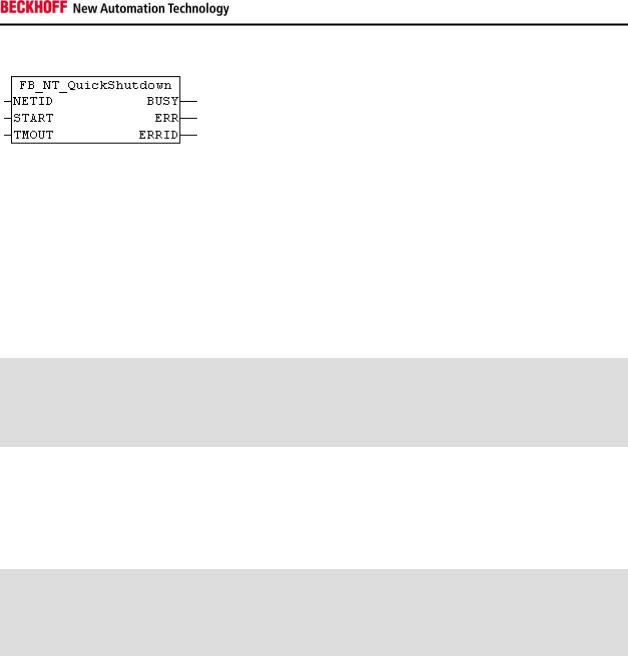
Notes on the documentation
FUNCTION_BLOCK FB_NT_QuickShutdown
The function block FB_NT_QuickShutdown is used to immediately reboot the PC without stopping TwinCAT or the operating system Windows.
Attention:
The function block FB_NT_QuickShutdown is used internally from FB_S_UPS and is not intended to be used elsewhere!
FUNCTION_BLOCK FB_NT_QuickShutdown
VAR_INPUT
VAR_INPUT
NETID :T_AmsNetId;
START :BOOL;
TMOUT :TIME := DEFAULT_ADS_TIMEOUT;
END_VAR
NETID |
: AmsNetID of the PC. |
START |
: rising edge leads to an immediate reboot of the PC. |
TMOUT |
: Timeout time. |
VAR_OUTPUT
VAR_OUTPUT
BUSY :BOOL;
ERR :BOOL;
ERRID :UDINT;
END_VAR
BUSY |
: The QuickShutdown is being executed. |
ERR |
: Is TRUE, if an error occurs. |
ERRID |
: Delivers the error number in case that ERR is TRUE. |
CX50x0 - Hardware Documentation |
21 |
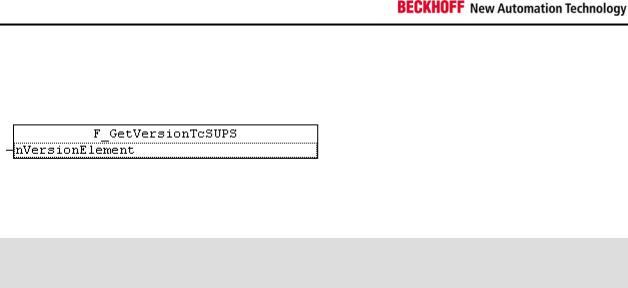
Notes on the documentation
Functions
FUNCTION F_GetVersionTcSUPS
The function returns library version info.
FUNCTION F_GetVersionTcSUPS : UINT
VAR_INPUT
nVersionElement : INT;
END_VAR
nVersionElement : Version element:
1 : major number;
2 : minor number;
3 : revision number;
|
Development environment |
|
|
Target plattform |
|
|
PLC Libraries to include |
|
|
|
|
|
|
|
|||
|
|
|
|
|||||
|
TwinCAT v2.11.0 |
PC (i386) |
TcSUPS.Lib |
|||||
22 |
CX50x0 - Hardware Documentation |
